| ( ! ) Warning: Undefined array key "blockId" in /home/kbxmjwdb/public_html/wp-content/plugins/table-of-contents-block/table-of-contents-block.php on line 159 | ||||
|---|---|---|---|---|
| Call Stack | ||||
| # | Time | Memory | Function | Location |
| 1 | 0.0001 | 353960 | {main}( ) | .../index.php:0 |
| 2 | 0.0001 | 354320 | require( '/home/kbxmjwdb/public_html/wp-blog-header.php ) | .../index.php:17 |
| 3 | 0.1235 | 10559184 | require_once( '/home/kbxmjwdb/public_html/wp-includes/template-loader.php ) | .../wp-blog-header.php:19 |
| 4 | 0.2234 | 18270888 | include( '/home/kbxmjwdb/public_html/wp-content/themes/generatepress/single.php ) | .../template-loader.php:106 |
| 5 | 0.3108 | 19790904 | generate_do_template_part( $template = 'single' ) | .../single.php:29 |
| 6 | 0.3108 | 19790904 | get_template_part( $slug = 'content', $name = 'single', $args = ??? ) | .../theme-functions.php:568 |
| 7 | 0.3108 | 19791424 | locate_template( $template_names = [0 => 'content-single.php', 1 => 'content.php'], $load = TRUE, $load_once = FALSE, $args = [] ) | .../general-template.php:206 |
| 8 | 0.3109 | 19791536 | load_template( $_template_file = '/home/kbxmjwdb/public_html/wp-content/themes/generatepress/content-single.php', $load_once = FALSE, $args = [] ) | .../template.php:745 |
| 9 | 0.3109 | 19791952 | require( '/home/kbxmjwdb/public_html/wp-content/themes/generatepress/content-single.php ) | .../template.php:812 |
| 10 | 0.3121 | 19839680 | the_content( $more_link_text = ???, $strip_teaser = ??? ) | .../content-single.php:73 |
| 11 | 0.3122 | 19839680 | apply_filters( $hook_name = 'the_content', $value = '<!-- wp:paragraph -->\n<p><strong>NCERT solutions for Class 9 Maths Chapter 1 – Number Systems (updated)</strong></p>\n<!-- /wp:paragraph -->\n\n<!-- wp:table-of-contents-block/table-of-contents-block {"headers":[{"level":2,"content":"Exercise 1.1 Page: 5","text":"Exercise 1.1 Page: 5","link":"exercise-11-page-5"},{"level":2,"content":"Exercise 1.2 Page: 8","text":"Exercise 1.2 Page: 8","link":"exercise-12-page-8"},{"level":2,"content":"Exercise 1.3 Page: 14","text":"Exercise 1.3 Page: 14","link":"exercise-13'... ) | .../post-template.php:256 |
| 12 | 0.3122 | 19840088 | WP_Hook->apply_filters( $value = '<!-- wp:paragraph -->\n<p><strong>NCERT solutions for Class 9 Maths Chapter 1 – Number Systems (updated)</strong></p>\n<!-- /wp:paragraph -->\n\n<!-- wp:table-of-contents-block/table-of-contents-block {"headers":[{"level":2,"content":"Exercise 1.1 Page: 5","text":"Exercise 1.1 Page: 5","link":"exercise-11-page-5"},{"level":2,"content":"Exercise 1.2 Page: 8","text":"Exercise 1.2 Page: 8","link":"exercise-12-page-8"},{"level":2,"content":"Exercise 1.3 Page: 14","text":"Exercise 1.3 Page: 14","link":"exercise-13'..., $args = [0 => '<!-- wp:paragraph -->\n<p><strong>NCERT solutions for Class 9 Maths Chapter 1 – Number Systems (updated)</strong></p>\n<!-- /wp:paragraph -->\n\n<!-- wp:table-of-contents-block/table-of-contents-block {"headers":[{"level":2,"content":"Exercise 1.1 Page: 5","text":"Exercise 1.1 Page: 5","link":"exercise-11-page-5"},{"level":2,"content":"Exercise 1.2 Page: 8","text":"Exercise 1.2 Page: 8","link":"exercise-12-page-8"},{"level":2,"content":"Exercise 1.3 Page: 14","text":"Exercise 1.3 Page: 14","link":"exercise-13'...] ) | .../plugin.php:205 |
| 13 | 0.3129 | 19841624 | do_blocks( $content = '<!-- wp:paragraph -->\n<p><strong>NCERT solutions for Class 9 Maths Chapter 1 – Number Systems (updated)</strong></p>\n<!-- /wp:paragraph -->\n\n<!-- wp:table-of-contents-block/table-of-contents-block {"headers":[{"level":2,"content":"Exercise 1.1 Page: 5","text":"Exercise 1.1 Page: 5","link":"exercise-11-page-5"},{"level":2,"content":"Exercise 1.2 Page: 8","text":"Exercise 1.2 Page: 8","link":"exercise-12-page-8"},{"level":2,"content":"Exercise 1.3 Page: 14","text":"Exercise 1.3 Page: 14","link":"exercise-13'... ) | .../class-wp-hook.php:324 |
| 14 | 0.3162 | 20554728 | render_block( $parsed_block = ['blockName' => 'table-of-contents-block/table-of-contents-block', 'attrs' => ['headers' => [...], 'title' => 'Chapter 1 – Number Systems'], 'innerBlocks' => [], 'innerHTML' => '\n<div class="wp-block-table-of-contents-block-table-of-contents-block eb-toc-container" style="border:undefinedpx solid black;background:#fff6f3;box-shadow:0px 0px 0px 0px black;width:100%" data-collapsible="false" data-initial-collapse="false" data-scroll-top="false" data-sticky="false" data-text-color="#707070" data-hide-mobile="false" data-title-bg="#ff7d50" data-title-color="white"><div class="eb-toc-header"><div class="eb-toc-title" style="display:block;font-size:22px;font-weight:normal;letter-spacing:'..., 'innerContent' => [0 => '\n<div class="wp-block-table-of-contents-block-table-of-contents-block eb-toc-container" style="border:undefinedpx solid black;background:#fff6f3;box-shadow:0px 0px 0px 0px black;width:100%" data-collapsible="false" data-initial-collapse="false" data-scroll-top="false" data-sticky="false" data-text-color="#707070" data-hide-mobile="false" data-title-bg="#ff7d50" data-title-color="white"><div class="eb-toc-header"><div class="eb-toc-title" style="display:block;font-size:22px;font-weight:normal;letter-spacing:'...]] ) | .../blocks.php:1743 |
| 15 | 0.3162 | 20555328 | WP_Block->render( $options = ??? ) | .../blocks.php:1705 |
| 16 | 0.3162 | 20556024 | {closure:/home/kbxmjwdb/public_html/wp-content/plugins/table-of-contents-block/table-of-contents-block.php:116-270}( $attributes = ['headers' => [0 => [...], 1 => [...], 2 => [...], 3 => [...], 4 => [...], 5 => [...], 6 => [...]], 'title' => 'Chapter 1 – Number Systems'], $content = '\n<div class="wp-block-table-of-contents-block-table-of-contents-block eb-toc-container" style="border:undefinedpx solid black;background:#fff6f3;box-shadow:0px 0px 0px 0px black;width:100%" data-collapsible="false" data-initial-collapse="false" data-scroll-top="false" data-sticky="false" data-text-color="#707070" data-hide-mobile="false" data-title-bg="#ff7d50" data-title-color="white"><div class="eb-toc-header"><div class="eb-toc-title" style="display:block;font-size:22px;font-weight:normal;letter-spacing:'..., class WP_Block { public $parsed_block = ['blockName' => 'table-of-contents-block/table-of-contents-block', 'attrs' => [...], 'innerBlocks' => [...], 'innerHTML' => '\n<div class="wp-block-table-of-contents-block-table-of-contents-block eb-toc-container" style="border:undefinedpx solid black;background:#fff6f3;box-shadow:0px 0px 0px 0px black;width:100%" data-collapsible="false" data-initial-collapse="false" data-scroll-top="false" data-sticky="false" data-text-color="#707070" data-hide-mobile="false" data-title-bg="#ff7d50" data-title-color="white"><div class="eb-toc-header"><div class="eb-toc-title" style="display:block;font-size:22px;font-weight:normal;letter-spacing:'..., 'innerContent' => [...]]; public $name = 'table-of-contents-block/table-of-contents-block'; public $block_type = class WP_Block_Type { public $api_version = 2; public $name = 'table-of-contents-block/table-of-contents-block'; public $title = 'Table Of Contents'; public $category = 'widgets'; public $parent = NULL; public $ancestor = NULL; public $allowed_blocks = NULL; public $icon = NULL; public $description = 'Insert Table of Contents on your posts/pages and enhance user experience on your WordPress website'; public $keywords = [...]; public $textdomain = NULL; public $styles = [...]; private $variations = NULL; public $variation_callback = NULL; public $selectors = [...]; public $supports = [...]; public $example = NULL; public $render_callback = class Closure { virtual $closure = "{closure}", ... }; public $attributes = [...]; private $uses_context = [...]; public $provides_context = NULL; public $block_hooks = [...]; public $editor_script_handles = [...]; public $script_handles = [...]; public $view_script_handles = [...]; public $view_script_module_ids = [...]; public $editor_style_handles = [...]; public $style_handles = [...]; public $view_style_handles = [...]; private $deprecated_properties = [...] }; public $context = []; protected $available_context = ['postId' => 17078, 'postType' => 'post']; protected $registry = class WP_Block_Type_Registry { private $registered_block_types = [...] }; public $inner_blocks = []; public $inner_html = '\n<div class="wp-block-table-of-contents-block-table-of-contents-block eb-toc-container" style="border:undefinedpx solid black;background:#fff6f3;box-shadow:0px 0px 0px 0px black;width:100%" data-collapsible="false" data-initial-collapse="false" data-scroll-top="false" data-sticky="false" data-text-color="#707070" data-hide-mobile="false" data-title-bg="#ff7d50" data-title-color="white"><div class="eb-toc-header"><div class="eb-toc-title" style="display:block;font-size:22px;font-weight:normal;letter-spacing:'...; public $inner_content = [0 => '\n<div class="wp-block-table-of-contents-block-table-of-contents-block eb-toc-container" style="border:undefinedpx solid black;background:#fff6f3;box-shadow:0px 0px 0px 0px black;width:100%" data-collapsible="false" data-initial-collapse="false" data-scroll-top="false" data-sticky="false" data-text-color="#707070" data-hide-mobile="false" data-title-bg="#ff7d50" data-title-color="white"><div class="eb-toc-header"><div class="eb-toc-title" style="display:block;font-size:22px;font-weight:normal;letter-spacing:'...]; public $attributes = ['headers' => [...], 'title' => 'Chapter 1 – Number Systems'] } ) | .../class-wp-block.php:463 |
NCERT solutions for Class 9 Maths Chapter 1 – Number Systems (updated)
Exercise 1.1 Page: 5
1. Is zero a rational number? Can you write it in the form p/q where p and q are integers and q ≠ 0?
Solution:
We know that, a number is said to be rational if it can be written in the form p/q , where p and q are integers and q ≠ 0.
Taking the case of ‘0’,
Zero can be written in the form 0/1, 0/2, 0/3 … as well as , 0/1, 0/2, 0/3 ..
Since it satisfies the necessary condition, we can conclude that 0 can be written in the p/q form, where q can either be positive or negative number.
Hence, 0 is a rational number.
2. Find six rational numbers between 3 and 4.
Solution:
There are infinite rational numbers between 3 and 4.
As we have to find 6 rational numbers between 3 and 4, we will multiply both the numbers, 3 and 4, with 6+1 = 7 (or any number greater than 6)
i.e., 3 × (7/7) = 21/7
and, 4 × (7/7) = 28/7. The numbers in between 21/7 and 28/7 will be rational and will fall between 3 and 4.
Hence, 22/7, 23/7, 24/7, 25/7, 26/7, 27/7 are the 6 rational numbers between 3 and 4.
3. Find five rational numbers between 3/5 and 4/5.
Solution:
There are infinite rational numbers between 3/5 and 4/5.
To find out 5 rational numbers between 3/5 and 4/5, we will multiply both the numbers 3/5 and 4/5
with 5+1=6 (or any number greater than 5)
i.e., (3/5) × (6/6) = 18/30
and, (4/5) × (6/6) = 24/30
The numbers in between18/30 and 24/30 will be rational and will fall between 3/5 and 4/5.
Hence,19/30, 20/30, 21/30, 22/30, 23/30 are the 5 rational numbers between 3/5 and 4/5
4. State whether the following statements are true or false. Give reasons for your answers.
(i) Every natural number is a whole number.
Solution:
True
Natural numbers- Numbers starting from 1 to infinity (without fractions or decimals)
i.e., Natural numbers= 1,2,3,4…
Whole numbers- Numbers starting from 0 to infinity (without fractions or decimals)
i.e., Whole numbers= 0,1,2,3…
Or, we can say that whole numbers have all the elements of natural numbers and zero.
Every natural number is a whole number; however, every whole number is not a natural number.
(ii) Every integer is a whole number.
Solution:
False
Integers- Integers are set of numbers that contain positive, negative and 0; excluding fractional and decimal numbers.
i.e., integers= {…-4,-3,-2,-1,0,1,2,3,4…}
Whole numbers- Numbers starting from 0 to infinity (without fractions or decimals)
i.e., Whole numbers= 0,1,2,3….
Hence, we can say that integers include whole numbers as well as negative numbers.
Every whole number is an integer; however, every integer is not a whole number.
(iii) Every rational number is a whole number.
Solution:
False
Rational numbers- All numbers in the form p/q, where p and q are integers and q≠0.
i.e., Rational numbers = 0, 19/30 , 2, 9/-3, -12/7…
Whole numbers- Numbers starting from 0 to infinity (without fractions or decimals)
i.e., Whole numbers= 0,1,2,3….
Hence, we can say that integers includes whole numbers as well as negative numbers.
Every whole numbers are rational, however, every rational numbers are not whole numbers.
Exercise 1.2 Page: 8
1. State whether the following statements are true or false. Justify your answers.
(i) Every irrational number is a real number.
Solution:
True
Irrational Numbers – A number is said to be irrational, if it cannot be written in the p/q, where p and q are integers and q ≠ 0.
i.e., Irrational numbers = π, e, √3, 5+√2, 6.23146…. , 0.101001001000….
Real numbers – The collection of both rational and irrational numbers are known as real numbers.
i.e., Real numbers = √2, √5, , 0.102…
Every irrational number is a real number, however, every real numbers are not irrational numbers.
(ii) Every point on the number line is of the form √m where m is a natural number.
Solution:
False
The statement is false since as per the rule, a negative number cannot be expressed as square roots.
E.g., √9 =3 is a natural number.
But √2 = 1.414 is not a natural number.
Similarly, we know that there are negative numbers on the number line but when we take the root of a negative number it becomes a complex number and not a natural number.
E.g., √-7 = 7i, where i = √-1
The statement that every point on the number line is of the form √m, where m is a natural number is false.
(iii) Every real number is an irrational number.
Solution:
False
The statement is false, the real numbers include both irrational and rational numbers. Therefore, every real number cannot be an irrational number.
Real numbers – The collection of both rational and irrational numbers are known as real numbers.
i.e., Real numbers = √2, √5, , 0.102…
Irrational Numbers – A number is said to be irrational, if it cannot be written in the p/q, where p and q are integers and q ≠ 0.
i.e., Irrational numbers = π, e, √3, 5+√2, 6.23146…. , 0.101001001000….
Every irrational number is a real number, however, every real number is not irrational.
2. Are the square roots of all positive integers irrational? If not, give an example of the square root of a number that is a rational number.
Solution:
No, the square roots of all positive integers are not irrational.
For example,
√4 = 2 is rational.
√9 = 3 is rational.
Hence, the square roots of positive integers 4 and 9 are not irrational. ( 2 and 3, respectively).
3. Show how √5 can be represented on the number line.
Solution:
Step 1: Let line AB be of 2 unit on a number line.
Step 2: At B, draw a perpendicular line BC of length 1 unit.
Step 3: Join CA
Step 4: Now, ABC is a right angled triangle. Applying Pythagoras theorem,
AB2+BC2 = CA2
22+12 = CA2 = 5
⇒ CA = √5 . Thus, CA is a line of length √5 unit.
Step 4: Taking CA as a radius and A as a center draw an arc touching
the number line. The point at which number line get intersected by
arc is at √5 distance from 0 because it is a radius of the circle
whose center was A.
Thus, √5 is represented on the number line as shown in the figure.
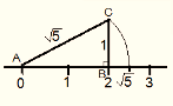
4. Classroom activity (Constructing the ‘square root spiral’) : Take a large sheet of paper and construct the ‘square root spiral’ in the following fashion. Start with a point O and draw a line segment OP1 of unit length. Draw a line segment P1P2 perpendicular to OP1 of unit length (see Fig. 1.9). Now draw a line segment P2P3 perpendicular to OP2. Then draw a line segment P3P4 perpendicular to OP3. Continuing in Fig. 1.9 :
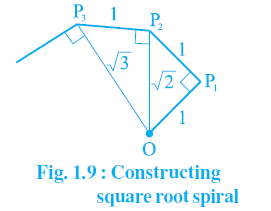
Constructing this manner, you can get the line segment Pn-1Pn by square root spiral drawing a line segment of unit length perpendicular to OPn-1. In this manner, you will have created the points P2, P3,….,Pn,… ., and joined them to create a beautiful spiral depicting √2, √3, √4, …
Solution:
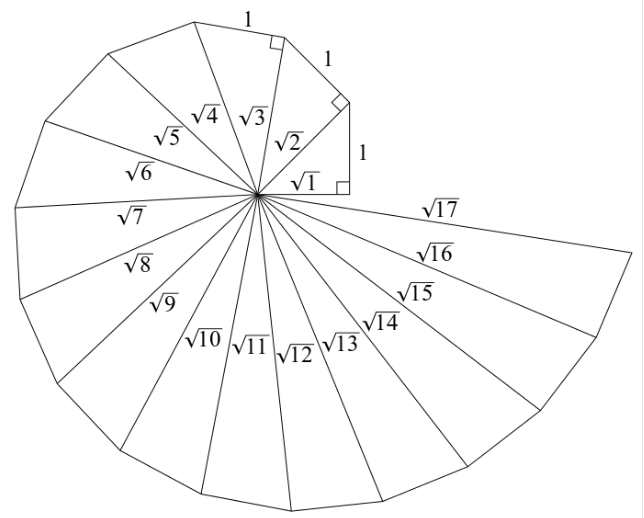
Step 1: Mark a point O on the paper. Here, O will be the center of the square root spiral.
Step 2: From O, draw a straight line, OA, of 1cm horizontally.
Step 3: From A, draw a perpendicular line, AB, of 1 cm.
Step 4: Join OB. Here, OB will be of √2
Step 5: Now, from B, draw a perpendicular line of 1 cm and mark the end point C.
Step 6: Join OC. Here, OC will be of √3
Step 7: Repeat the steps to draw √4, √5, √6….
Exercise 1.3 Page: 14
1. Write the following in decimal form and say what kind of decimal expansion each has :
(i) 36/100
Solution:
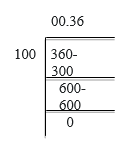
= 0.36 (Terminating)
(ii)1/11
Solution:
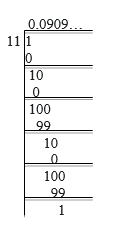


Solution:

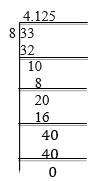
= 4.125 (Terminating)
(iv) 3/13
Solution:


(v) 2/11
Solution:
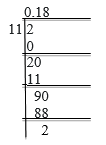
(vi) 329/400
Solution:
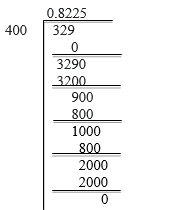
= 0.8225 (Terminating)
2. You know that 1/7 = 0.142857. Can you predict what the decimal expansions of 2/7, 3/7, 4/7, 5/7, 6/7 are, without actually doing the long division? If so, how?
[Hint: Study the remainders while finding the value of 1/7 carefully.]
Solution:
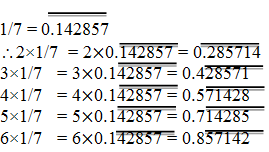
3. Express the following in the form p/q, where p and q are integers and q 0.
(i)
Solution:

Assume that x = 0.666…
Then,10x = 6.666…
10x = 6 + x
9x = 6
x = 2/3
(ii) 0.4\overline{7}0.47
Solution:0.4\overline{7} = 0.4777..0.47=0.4777..
= (4/10)+(0.777/10)
Assume that x = 0.777…
Then, 10x = 7.777…
10x = 7 + x
x = 7/9
(4/10)+(0.777../10) = (4/10)+(7/90) ( x = 7/9 and x = 0.777…0.777…/10 = 7/(9×10) = 7/90 )
= (36/90)+(7/90) = 43/90

Solution:

Assume that x = 0.001001…
Then, 1000x = 1.001001…
1000x = 1 + x
999x = 1
x = 1/999
4. Express 0.99999…. in the form p/q . Are you surprised by your answer? With your teacher and classmates discuss why the answer makes sense.
Solution:
Assume that x = 0.9999…..Eq (a)
Multiplying both sides by 10,
10x = 9.9999…. Eq. (b)
Eq.(b) – Eq.(a), we get
(10x = 9.9999)-(x = 0.9999…)
9x = 9
x = 1
The difference between 1 and 0.999999 is 0.000001 which is negligible.
Hence, we can conclude that, 0.999 is too much near 1, therefore, 1 as the answer can be justified.
5. What can the maximum number of digits be in the repeating block of digits in the decimal expansion of 1/17 ? Perform the division to check your answer.
Solution:
1/17
Dividing 1 by 17:


There are 16 digits in the repeating block of the decimal expansion of 1/17.
6. Look at several examples of rational numbers in the form p/q (q ≠ 0), where p and q are integers with no common factors other than 1 and having terminating decimal representations (expansions). Can you guess what property q must satisfy?
Solution:
We observe that when q is 2, 4, 5, 8, 10… Then the decimal expansion is terminating. For example:
1/2 = 0. 5, denominator q = 21
7/8 = 0. 875, denominator q =23
4/5 = 0. 8, denominator q = 51
We can observe that the terminating decimal may be obtained in the situation where prime factorization of the denominator of the given fractions has the power of only 2 or only 5 or both.
7. Write three numbers whose decimal expansions are non-terminating non-recurring.
Solution:
We know that all irrational numbers are non-terminating non-recurring. three numbers with decimal expansions that are non-terminating non-recurring are:
- √3 = 1.732050807568
- √26 =5.099019513592
- √101 = 10.04987562112
8. Find three different irrational numbers between the rational numbers 5/7 and 9/11.
Solution:

Three different irrational numbers are:
- 0.73073007300073000073…
- 0.75075007300075000075…
- 0.76076007600076000076…
9. Classify the following numbers as rational or irrational according to their type:
(i)√23
Solution:
√23 = 4.79583152331…
Since the number is non-terminating non-recurring therefore, it is an irrational number.
(ii)√225
Solution:
√225 = 15 = 15/1
Since the number can be represented in p/q form, it is a rational number.
(iii) 0.3796
Solution:
Since the number,0.3796, is terminating, it is a rational number.
(iv) 7.478478
Solution:
The number,7.478478, is non-terminating but recurring, it is a rational number.
(v) 1.101001000100001…
Solution:
Since the number,1.101001000100001…, is non-terminating non-repeating (non-recurring), it is an irrational number.
Exercise 1.4 Page: 18
1. Visualise 3.765 on the number line, using successive magnification.
Solution:
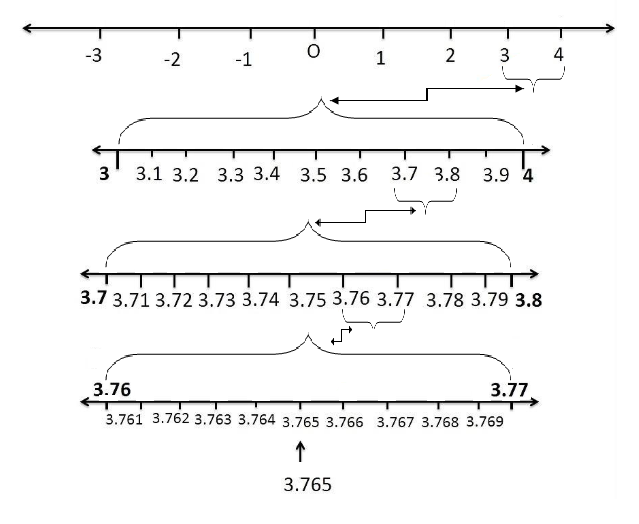

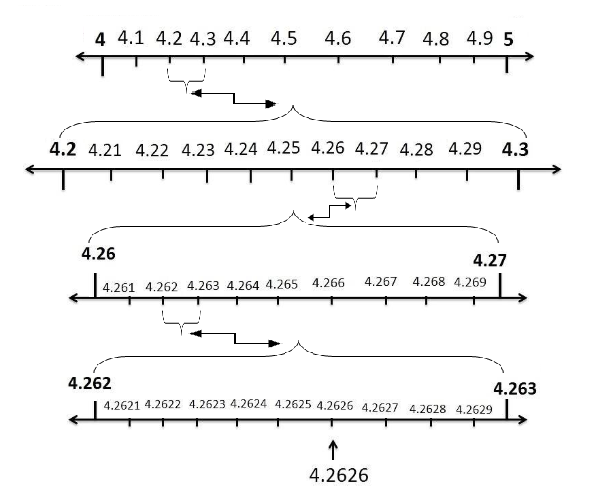
Exercise 1.5 Page: 24
1. Classify the following numbers as rational or irrational:
(i) 2 –√5
Solution:
We know that, √5 = 2.2360679…
Here, 2.2360679…is non-terminating and non-recurring.
Now, substituting the value of √5 in 2 –√5, we get,
2-√5 = 2-2.2360679… = -0.2360679
Since the number, – 0.2360679…, is non-terminating non-recurring, 2 –√5 is an irrational number.
(ii) (3 +√23)- √23
Solution:
(3 +√23) –√23 = 3+√23–√23
= 3
= 3/1
Since the number 3/1 is in p/q form, (3 +√23)- √23 is rational.
(iii) 2√7/7√7
Solution:
2√7/7√7 = ( 2/7)× (√7/√7)
We know that (√7/√7) = 1
Hence, ( 2/7)× (√7/√7) = (2/7)×1 = 2/7
Since the number, 2/7 is in p/q form, 2√7/7√7 is rational.
(iv) 1/√2
Solution:
Multiplying and dividing numerator and denominator by √2 we get,
(1/√2) ×(√2/√2)= √2/2 ( since √2×√2 = 2)
We know that, √2 = 1.4142…
Then, √2/2 = 1.4142/2 = 0.7071..
Since the number , 0.7071..is non-terminating non-recurring, 1/√2 is an irrational number.
(v) 2
Solution:
We know that, the value of = 3.1415
Hence, 2 = 2×3.1415.. = 6.2830…
Since the number, 6.2830…, is non-terminating non-recurring, 2 is an irrational number.
2. Simplify each of the following expressions:
(i) (3+√3)(2+√2)
Solution:
(3+√3)(2+√2 )
Opening the brackets, we get, (3×2)+(3×√2)+(√3×2)+(√3×√2)
= 6+3√2+2√3+√6
(ii) (3+√3)(3-√3 )
Solution:
(3+√3)(3-√3 ) = 32-(√3)2 = 9-3
= 6
(iii) (√5+√2)2
Solution:
(√5+√2)2 = √52+(2×√5×√2)+ √22
= 5+2×√10+2 = 7+2√10
(iv) (√5-√2)(√5+√2)
Solution:
(√5-√2)(√5+√2) = (√52-√22) = 5-2 = 3
3. Recall, π is defined as the ratio of the circumference (say c) of a circle to its diameter, (say d). That is, π =c/d. This seems to contradict the fact that π is irrational. How will you resolve this contradiction?
Solution:
There is no contradiction. When we measure a value with a scale, we only obtain an approximate value. We never obtain an exact value. Therefore, we may not realize whether c or d is irrational. The value of π is almost equal to 22/7 or 3.142857…
4. Represent (√9.3) on the number line.
Solution:
Step 1: Draw a 9.3 units long line segment, AB. Extend AB to C such that BC=1 unit.
Step 2: Now, AC = 10.3 units. Let the centre of AC be O.
Step 3: Draw a semi-circle of radius OC with centre O.
Step 4: Draw a BD perpendicular to AC at point B intersecting the semicircle at D. Join OD.
Step 5: OBD, obtained, is a right angled triangle.
Here, OD 10.3/2 (radius of semi-circle), OC = 10.3/2 , BC = 1
OB = OC – BC
⟹ (10.3/2)-1 = 8.3/2
Using Pythagoras theorem,
We get,
OD2=BD2+OB2
⟹ (10.3/2)2 = BD2+(8.3/2)2
⟹ BD2 = (10.3/2)2-(8.3/2)2
⟹ (BD)2 = (10.3/2)-(8.3/2)(10.3/2)+(8.3/2)
⟹ BD2 = 9.3
⟹ BD = √9.3
Thus, the length of BD is √9.3.
Step 6: Taking BD as radius and B as centre draw an arc which touches the line segment. The point where it touches the line segment is at a distance of √9.3 from O as shown in the figure.

5. Rationalize the denominators of the following:
(i) 1/√7
Solution:
Multiply and divide 1/√7 by √7
(1×√7)/(√7×√7) = √7/7
(ii) 1/(√7-√6)
Solution:
Multiply and divide 1/(√7-√6) by (√7+√6)[1/(√7-√6)]×(√7+√6)/(√7+√6) = (√7+√6)/(√7-√6)(√7+√6)
= (√7+√6)/√72-√62 [denominator is obtained by the property, (a+b)(a-b) = a2-b2]
= (√7+√6)/(7-6)
= (√7+√6)/1
= √7+√6
(iii) 1/(√5+√2)
Solution:
Multiply and divide 1/(√5+√2) by (√5-√2)[1/(√5+√2)]×(√5-√2)/(√5-√2) = (√5-√2)/(√5+√2)(√5-√2)
= (√5-√2)/(√52-√22) [denominator is obtained by the property, (a+b)(a-b) = a2-b2]
= (√5-√2)/(5-2)
= (√5-√2)/3
(iv) 1/(√7-2)
Solution:
Multiply and divide 1/(√7-2) by (√7+2)
1/(√7-2)×(√7+2)/(√7+2) = (√7+2)/(√7-2)(√7+2)
= (√7+2)/(√72-22) [denominator is obtained by the property, (a+b)(a-b) = a2-b2]
= (√7+2)/(7-4)
= (√7+2)/3
Exercise 1.6 Page: 26
1. Find:
(i)641/2
Solution:
641/2 = (8×8)1/2
= (82)½
= 81 [⸪2×1/2 = 2/2 =1]
= 8
(ii)321/5
Solution:
321/5 = (25)1/5
= (25)⅕
= 21 [⸪5×1/5 = 1]
= 2
(iii)1251/3
Solution:
(125)1/3 = (5×5×5)1/3
= (53)⅓
= 51 (3×1/3 = 3/3 = 1)
= 5
2. Find:
(i) 93/2
Solution:
93/2 = (3×3)3/2
= (32)3/2
= 33 [⸪2×3/2 = 3]
=27
(ii) 322/5
Solution:
322/5 = (2×2×2×2×2)2/5
= (25)2⁄5
= 22 [⸪5×2/5= 2]
= 4
(iii)163/4
Solution:
163/4 = (2×2×2×2)3/4
= (24)3⁄4
= 23 [⸪4×3/4 = 3]
= 8
(iv) 125-1/3
125-1/3 = (5×5×5)-1/3
= (53)-1⁄3
= 5-1 [⸪3×-1/3 = -1]
= 1/5
3. Simplify:
(i) 22/3×21/5
Solution:
22/3×21/5 = 2(2/3)+(1/5) [⸪Since, am×an=am+n____ Laws of exponents]
= 213/15 [⸪2/3 + 1/5 = (2×5+3×1)/(3×5) = 13/15]
(ii) (1/33)7
Solution:
(1/33)7 = (3-3)7 [⸪Since,(am)n = am x n____ Laws of exponents]
= 3-21
(iii) 111/2/111/4
Solution:
111/2/111/4 = 11(1/2)-(1/4)
= 111/4 [⸪(1/2) – (1/4) = (1×4-2×1)/(2×4) = 4-2)/8 = 2/8 = ¼ ]
(iv) 71/2×81/2
Solution:
71/2×81/2 = (7×8)1/2 [⸪Since, (am×bm = (a×b)m ____ Laws of exponents]
= 561/2










1 thought on “NCERT solutions Class 9 Maths Chapter 1 Number Systems”